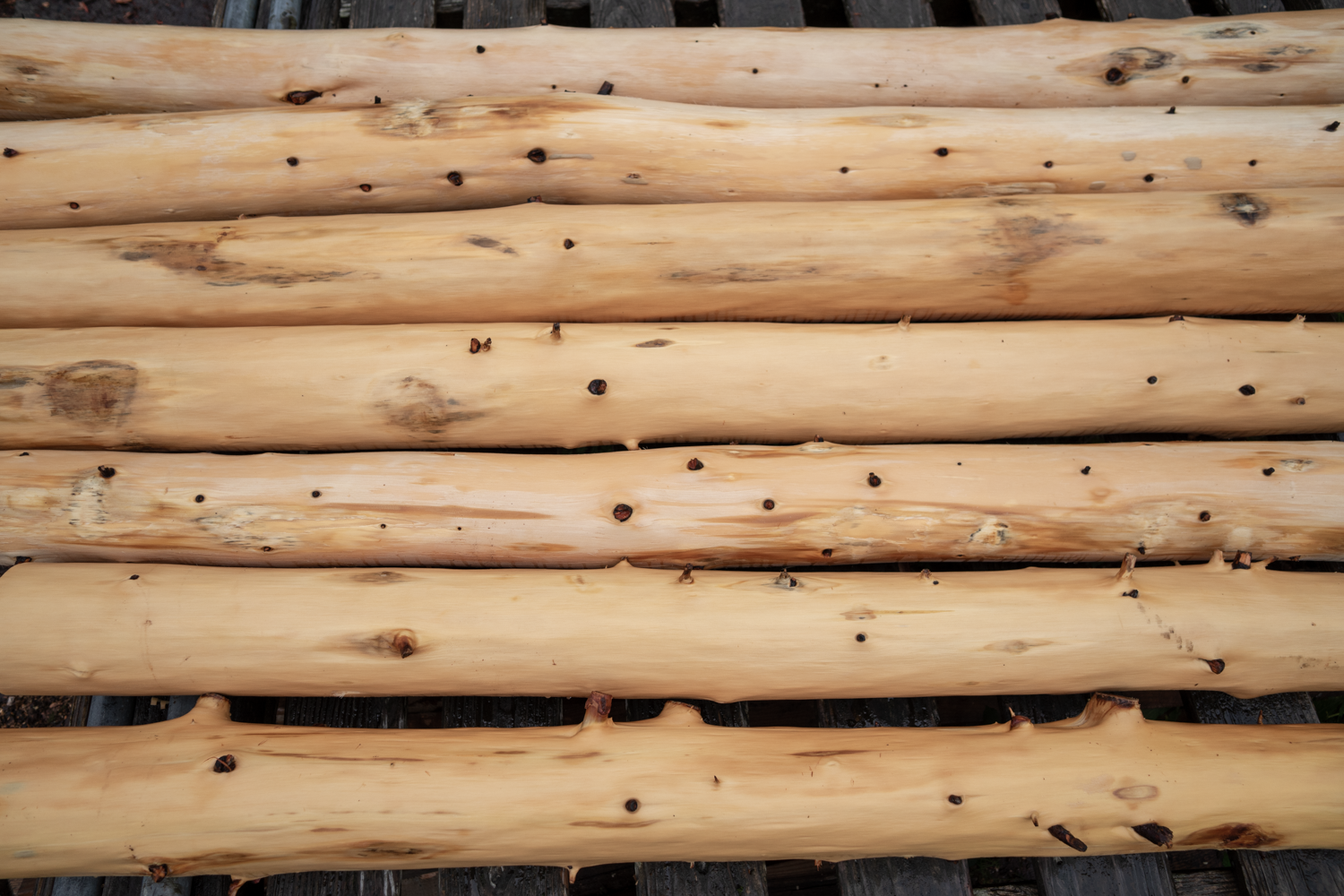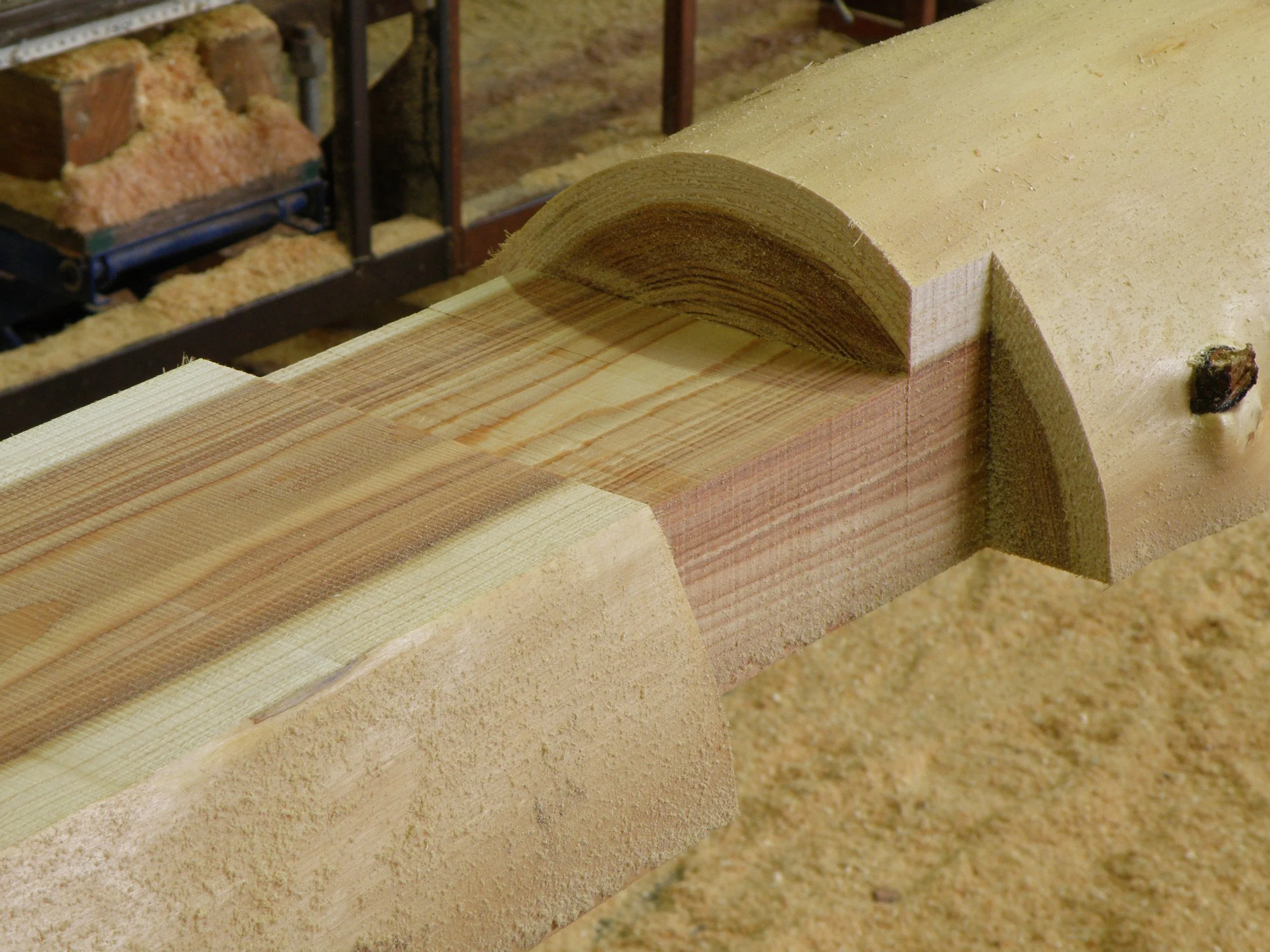Larch poles sold by the meter
These are the costs for each meter of log, diameter at the mid point, bark still on:
100 mm = £5.50 +VAT
160 mm = £12 +VAT
220 mm = £21 +VAT
280 mm = £30.70 +VAT
Prices for larch with bark sprayed off:
100 mm = £7.15 +VAT
160 mm = £15.60 +VAT
220 mm = £27.30 +VAT
280 mm = £39.91 +VAT
Collection from our workshop at BS32JT, delivery is available but is priced depending on your location.
For all enquiries please call Tom on 07971 985 310 or email us at info@roundwooddesign.co.uk
Why larch?
Larch offers a rare balance of durability, strength, and visual warmth, making it one of the most dependable species for roundpole timber framing. It performs well structurally, weathers gracefully, all while being widely available and relatively affordable. In both practical and aesthetic terms, it’s an excellent choice for anyone building with roundwood.
Larch is a particularly stable timber, forming small, fine radial cracks as it seasons — unlike oak, which tends to develop larger splits. This makes it well-behaved in buildings, where it moves predictably and ages gracefully over time. While the pale sapwood of larch is not durable for external use, its heartwood is naturally resilient, offering long-lasting performance outdoors when detailed and maintained correctly.
When designing with larch, it’s important to remember that while the heartwood is naturally durable, the sapwood is not — so careful detailing makes all the difference. We always recommend protecting larch from direct rainfall wherever possible and ensuring that every joint can shed water freely. Good design means avoiding trapped moisture: let the timber breathe, keep it well-drained, and it will weather beautifully for decades.
Larch is also a pleasure to work with — dense and strong, yet easy to machine and shape when green. Its distinctive grain and warm colour respond beautifully to planing, sanding, and oiling, allowing for either a refined or rustic finish depending on the project. We source UK-grown larch, ensuring consistency, traceability, and a low-carbon supply chain for every order.
Strength
Structurally, larch stands out as one of the strongest and stiffest softwoods. Its high modulus of elasticity and bending strength allow it to carry substantial loads and span wide distances without excessive deflection. The wood’s density and toughness also mean that it resists crushing at joints — a valuable quality in roundpole joinery, where compression strength is essential. In short, larch combines lightness with real mechanical integrity, making it both practical and reliable for timber framing.
Aesthetic Qualities
Aesthetically, larch has a rich and characterful appearance that suits the organic nature of roundpole construction. The heartwood ranges from warm golden-brown to a deeper reddish tone, and the grain is fine and expressive without being fussy. When exposed to the elements, larch weathers beautifully, taking on a silvery-grey patina that enhances its natural texture rather than diminishing it. This combination of strength and beauty makes it a favourite among framers who value the visual honesty and tactile quality of natural wood.
Our spraying process
From an ecological standpoint, the main factor to consider is water use. Stripping bark in this way can consume a significant amount of water if done from a mains supply, which is why we’ve integrated a closed-loop, rain-fed system into our yard. All of the water used for cleaning poles is drawn from a 6,000-litre rainwater collection tank, which gathers runoff from nearby roofs and hardstanding areas. By working from this stored supply, we eliminate the need for mains water and make the process almost entirely self-sufficient and sustainable.
Because the water is simply directed at the bark and not mixed with any additives, it can safely return to the ground through natural drainage. The bark itself, once loosened, breaks down quickly as organic matter, so there’s no harmful waste stream to manage. Compared to other methods — such as mechanical debarking machines that consume fuel and produce coarse waste — pressure-washing with rainwater represents a low-energy, low-emission approach that complements the ecological ethos of roundwood building.
To remove bark efficiently from freshly felled poles, we use a Kranzle Quadro 11/140 TST three-phase pressure washer, which delivers enough power to lift bark cleanly without damaging the wood beneath. Manual debarking with drawknives or spuds can be slow and physically demanding, particularly on resinous or fibrous species like larch, but the high-pressure water jet from the Kranzle gets under the cambium layer and peels the bark away with precision. It works especially well when the timber is still green and the sapwood moist, allowing the bark to separate easily, even around knots and irregular sections where hand tools often struggle. For larger batches of poles — such as those destined for timber frames, cabins, or fencing — this method dramatically reduces labour time while producing a clean, natural finish that preserves the integrity of the wood.
Unlike mechanical debarking tools or drawknives, which can gouge or score the wood if handled carelessly, a pressure washer preserves the natural surface of the pole. It removes only the bark and cambium layer, leaving the underlying wood intact and smooth. This is especially valued in roundpole framing, where the tactile, natural character of the timber is part of the aesthetic. It also means less sanding or cleanup later on.







